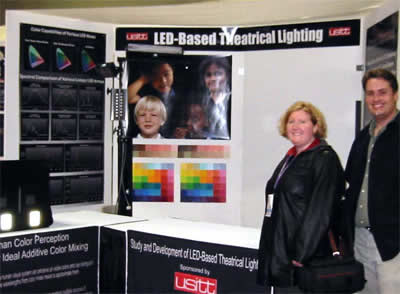 |
 |
 |
|
 |
The LED research project funded by USITT's Grants & Fellowship Program was presented at this booth and in a session during the 2003 Annual Conference & Stage Expo in Minneapolis. Kimberley Gerlach and Robert Gerlach were on hand to explain the research to visitors. |
|
|
Grants & Fellowships:
A Success Story When Ed Kook declared that USITT needed to provide financial resources for research and development in the technical theatre industry, he put his money where he knew it would produce results. Mr. Kook created the Edward F. Kook Endowment Fund to promote the sort of innovative thinking he and Joe Levy used in 1933 when they developed the LEKO. In 1985, then USITT President Randy Earle, established the Endowment Management Committee to administer a grants and fellowships program which is funded in part by the Kook fund. This program spoke directly to Mr. Kook's vision by seeking out individuals, groups, and organizations who had the start of an innovative idea but lacked financial resources to develop it. Since the inception of the program, 33 Project Grants and nine Fellowships have been aided by the distribution of over $200,000 in Institute funding. The next opportunity to apply for assistance from the program closes on January 10, 2008. A PDF of the application and instructions on how to apply can be found here. The Grants &Fellowships Committee interacts with many of the Institutes' creative thinkers by helping them realize their projects. There is one particular instance to illuminate an extraordinary example of a project that has brought benefit, not only to USITT members, but across the industry. In 2001 the Grants &Fellowship Committee recommended funding a project titled Development and Study of LED-based Theatrical Lighting. This was hot button research at a period of time when many in the industry were looking for theatre applications with this promising technology. Although work had been done in the area, researchers Robert Gerlach, Novella Smith, and others on their team, identified two critical problems with recent developments; insufficient luminous output and unacceptable color management. The project set out with an analytical approach to undertake a study, which included many USITT members, for the purpose of testing human color perception in theatrical applications. The color analysis step was vital to their eventual goal of developing a theatrical lighting instrument. Once they had sufficient data on color perception, they went forward to determine what combination of LEDs would provide the desired results. The next step was electrical engineering and design for a lighting unit encompassing all of the research that their two years of study had produced. As one of the conditions of the USITT grant, it was necessary to provide as much information as possible to Institute members on their findings. This was accomplished by demonstrations and sessions at USITT's 2003 Annual Conference & Stage Expo in Minneapolis. To provide information to an even wider audience, a detailed article was published in the Fall 2003 issue of TD&T. In every publication dealing with this research, both print and web format, the USITT Grants & Fellowships Program has been credited with assisting this project. Fast forward to 2007 at an open house by Barbizon, one of Denver's premier entertainment industry supply companies, where there were a number of new products being showcased. There was Mr. Gerlach, demonstrating an LED theatrical lighting fixture of his design and creation. In the four years since the completion of his grant project, he has poured an enormous amount of his own time and money into the actual development of a product. The initial research, however, came by way of the Institute's Grants & Fellowships program. USITT's Grants & Fellowship Program fulfills the Institute's mission of "promoting the advancement of the knowledge and skills of its members" by supporting research projects that promote lifelong learning and creative development. The LED project is just one of many such success stories that have benefited from funding by USITT as a result of one founder's foresight and its members' generosity. |
||